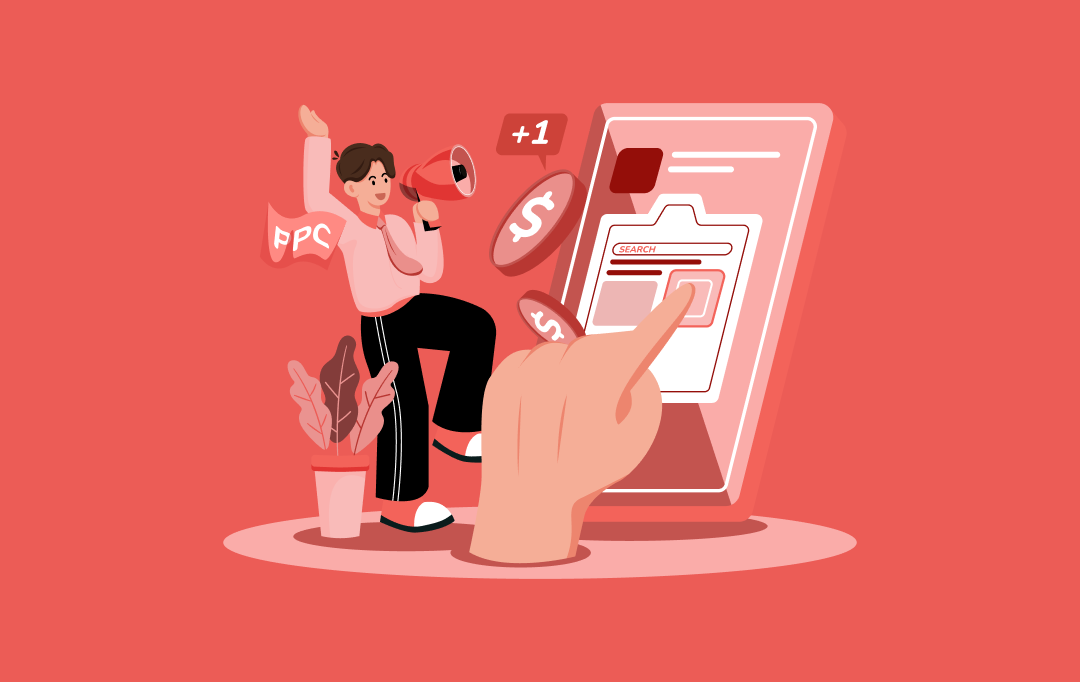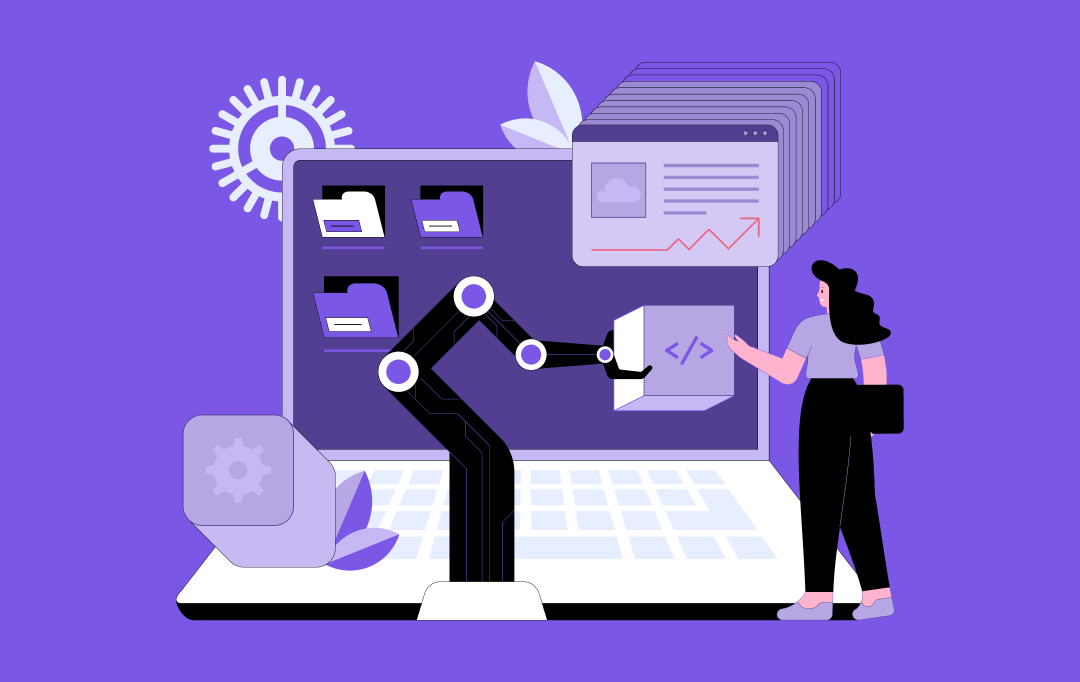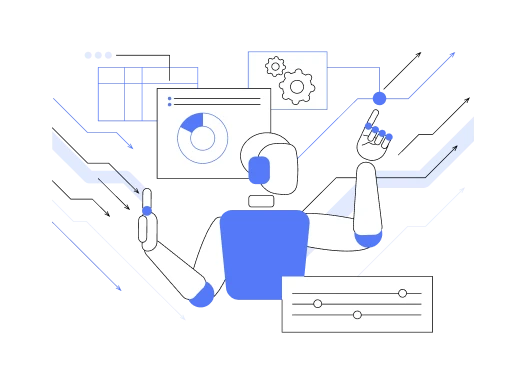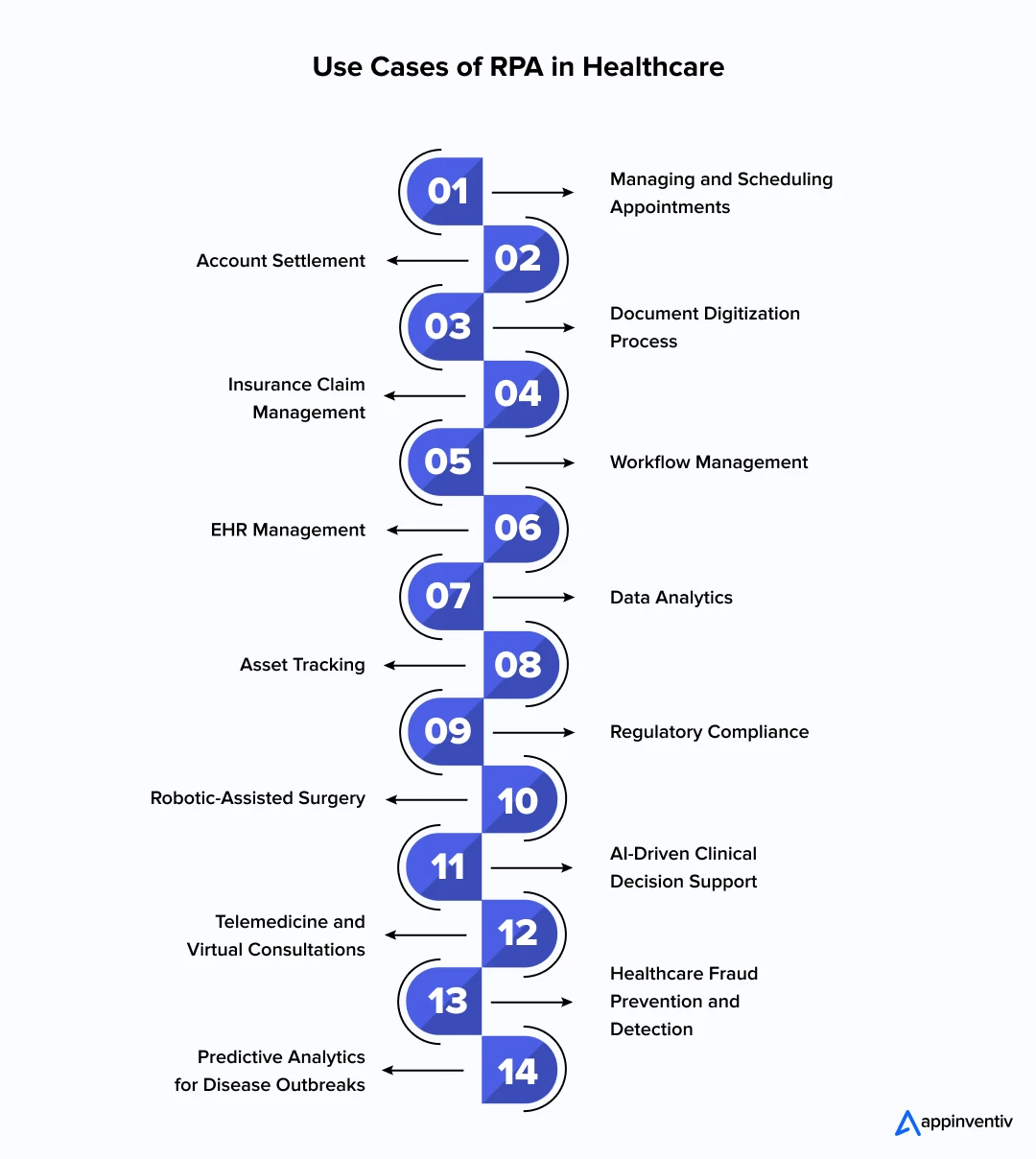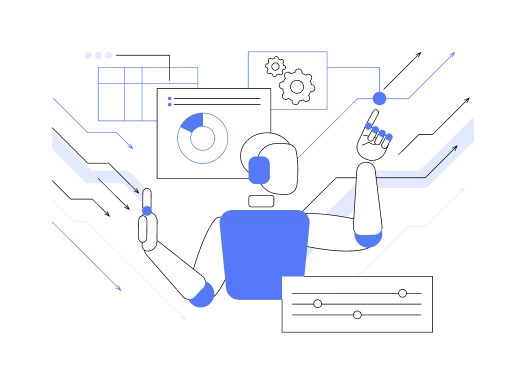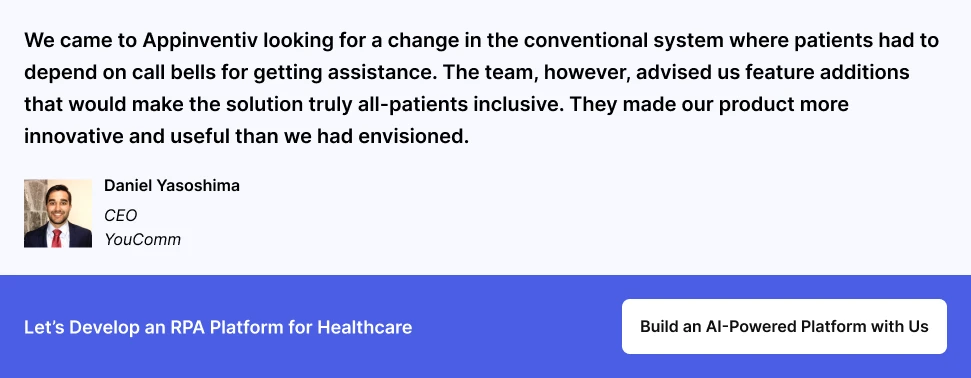- How Does RPA Function in Healthcare
- RPA Workflow in Healthcare
- Top 14 RPA Use Cases in Healthcare
- Managing and Scheduling Appointments
- Account Settlement
- Document Digitization Process
- Insurance Claim Management
- Workflow Management
- EHR Management
- Data Analytics
- Asset Tracking
- Regulatory Compliance
- Robotic-Assisted Surgery
- AI-Driven Clinical Decision Support
- Healthcare Fraud Prevention and Detection
- Predictive Analytics for Disease Outbreaks
- What Are the Benefits of Using RPA in Healthcare Operations?
- Personalized User Experience
- Increased Appointment Turnout
- Reduced Risk of Human Errors
- Better Employee Satisfaction
- Cost Efficiency
- Better Data Protection
- Real-life Examples of RPA in Healthcare: How Organizations Worldwide Are Leveraging the Power of Automation
- University Hospitals Birmingham
- GE Healthcare
- McKesson Corporation
- Northampton General Hospital
- How to Implement RPA in Healthcare - A Step-by-Step Process
- Identify Suitable Processes
- Select the Right RPA Partner
- Discuss Your RPA Requirements
- Develop and Deploy RPA in Your Business
- Monitor and Optimize Performance
- Measure Implementation Cost and ROI Opportunities
- Stay Informed
- Implementation Challenges for RPA in Healthcare and How to Overcome Them
- Regulatory Compliance
- Change Management
- Complex IT Infrastructure
- Scalability and Maintenance
- Cost of RPA Implementation in Healthcare
- The Future of RPA in Healthcare
- Key Trends Shaping the Future in the Coming Years
- How Can Appinventiv Help Implement RPA in Healthcare?
- FAQs
Key takeaways:
- Robotic process automation in healthcare market is poised to reach $14.18 billion by 2032.
- RPA in healthcare automates repetitive tasks like scheduling, claims processing, patient data management and a lot more.
- Compliance with healthcare robotic process automation like HIPAA and GDPR is critical to ensure the successful implementation of RPA in healthcare.
- The cost of RPA implementation in healthcare ranges between $50,000 and $500,000 or more.
The modern healthcare industry is under immense pressure: rising patient volumes, mounting administrative tasks, and relentless regulatory requirements are pushing hospitals and clinics to their limits. What’s even more pressing is that healthcare currently faces an unprecedented efficiency crisis, with an anticipated shortage of 37,800 to 124,000 physicians by 2034.
In this high-stakes environment, even a small inefficiency can mean delayed care, frustrated staff, or mounting costs. But what if you could automate the most tedious, error-prone processes, freeing up your team to focus on what truly matters: patient care?
That’s exactly what leading healthcare organizations are doing with Robotic Process Automation (RPA). For example:
- University Hospitals Birmingham deployed RPA-powered self-service kiosks for patient registration. Result? They doubled patient throughput and improved front-desk efficiency by 50%, all without hiring additional staff.
- Likewise, GE Healthcare has harnessed RPA to streamline reimbursement and claims processes, reducing billing errors and accelerating payments.
The impact isn’t limited to a handful of pioneers. The global RPA in healthcare market was valued at $1.4 billion in 2022 and is projected to skyrocket to $14.18 billion by 2032, growing at a staggering CAGR of 26.1% (Precedence Research). According to the 2024 CAQH Index, the healthcare sector can save over $20 billion by shifting focus from manual processes to automated ones.
Interested in exploring more about the role of healthcare RPA? Then this blog is for you. In this blog, we’ll explore how RPA is revolutionizing healthcare operations, from appointment scheduling and claims management to compliance and beyond. Discover the real-world use cases, benefits, challenges, and actionable steps to bring the power of automation to your organization.
Why RPA healthcare platform development is your next big thing?
- $14.18 B global RPA healthcare market is expected to reach by 2032.
- 26.1% CAGR in the healthcare RPA market from 2022 to 2032.
- $20 B potential savings in healthcare by automating processes.
How Does RPA Function in Healthcare
RPA in healthcare has been a complete game-changer, providing immense benefits to the industry. It uses software robots or “bots” to mimic human actions to perform high-volume, rule-based, and repetitive tasks while interacting with various healthcare systems.
RPA Workflow in Healthcare
- Data Extraction
RPA bots begin by extracting data from various sources within the healthcare system, such as EHRs, patient portals, and insurance records. - Processing and Updating
RPA bots validate, organize, and update the data in relevant systems like billing, EHRs, or inventory systems. - Compliance and Accuracy Checks
RPA ensures that the processed data adheres to regulatory standards and verifies that it meets compliance requirements. - Information Feeding to Systems
At last, RPA feeds back the validated and updated information into the relevant healthcare systems, making it accessible for real-time use.
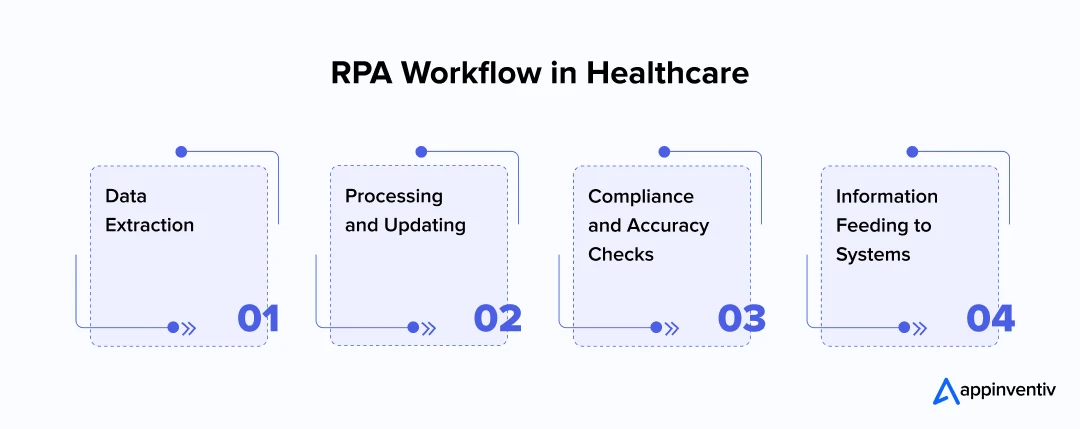
The implementation of RPA in healthcare tackles many complex tasks like patient registration, claims processing, data entry, report generation, etc. (details later). This 360-degree application of RPA for healthcare helps address nearly every challenge the industry faces, from improving patient care, freeing up physicians, ensuring precision, and streamlining operations to adhering to compliance with regulatory standards.
Let’s have an in-depth look at the multifarious role of RPA in the healthcare industry:
Top 14 RPA Use Cases in Healthcare
RPA in healthcare can efficiently automate tasks across the verticals of healthcare organizations, including records management, billing, and processing, to front-office tasks. Exploring further, the capabilities of robotics process automation in healthcare reveal its potential in transforming patient data management, operational efficiency and more.
To better understand why the healthcare industry should implement robotic process automation, let us look into some of the most common use cases of RPA in healthcare.
Managing and Scheduling Appointments
Through automation, RPA makes the appointment scheduling process quick and smooth without human intervention. Sending timely notifications to the patients and reminding them of the appointment makes the customer feel valued. Furthermore, it also informs the patients about any changes in the schedule because of the doctor’s unavailability, avoiding hassle and saving time.
Why It’s Great:
- Less waiting for patients.
- Fewer mistakes in booking.
- More time for the medical team to focus on actual patient care.
Also Read: How much a doctor appointment app like ZocDoc costs
Account Settlement
Healthcare delivery requires managing multiple accounts of the same patient through consultation, tests, medicines, etc. Managing and calculating them manually is prone to making errors while increasing the wait time. With robotic process automation in healthcare, organizations can bring all the accounts in one place and do the correct calculations in just a few clicks. Also, RPA speeds things up by making sure everything matches before payments are processed, and it keeps track of everything for quick reconciliation.
Why It’s Great:
- Faster payment processing.
- Fewer rejected claims.
- Easier tracking and reconciliation of payments.
Document Digitization Process
Gone are the days of dealing with stacks of paper. RPA for healthcare can scan patient repositories that contain data from their medical records to health insurance claims, converting them into digital files and storing them automatically. The cool part is that RPA doesn’t just convert them—it also checks that everything is accurate and puts it where it needs to go in the system, saving staff hours of work.
Why It’s Great:
- Instant access to records.
- More accurate data entry.
- Better for the environment (less paper!).
Insurance Claim Management
Insurance claims can be a headache, but RPA alleviates the pain. RPA in healthcare claims management processing automatically pulls information from patient records, double-checks the details against insurance policies, and submits claims without any human intervention. Automating the process ensures the shift completion of tasks while eliminating errors and adhering to all regulatory compliance.
Why It’s Great:
- Claims processed quicker.
- Fewer mistakes and rejections.
- Less manual data entry for staff.
Workflow Management
Managing workflows in healthcare isn’t easy, but with RPA, tasks like document routing or task assignments can be automated. For example, when a patient’s test results are in, RPA can automatically alert the right doctor or schedule a follow-up. It keeps everything moving smoothly, without unnecessary delays.
Why It’s Great:
- Streamlined operations across departments.
- Fewer bottlenecks and delays.
- Better team coordination.
EHR Management
RPA in Electronic Health Records (EHR) management possesses the capacity to revolutionize the entire healthcare industry. RPA bots can regularly monitor records from various sources to collect patient information and update their EHRs and EMRs. It can also download PDFs and other medical information from a variety of documents through OCR (Optical Character Recognition).
Why It’s Great:
- More accurate, up-to-date patient records.
- Faster updates, reducing errors.
- Easier access to critical patient info.
Data Analytics
RPA in data analytics can automatically collect and organize data from different sources like patient records, financial systems, operational reports, etc., and process it for analysis. It can even provide insights that help healthcare organizations make decisions faster. Essentially, RPA does the data crunching, so staff can focus on making better decisions.
Why It’s Great:
- Instant access to valuable data.
- Better decision-making with real-time insights.
- Predictive analytics to stay ahead of issues.
Also Read: A Complete Guide on Data Science & Analytics for Businesses
Asset Tracking
Medical staff often waste their valuable time searching for misplaced hospital equipment. This leads to work inefficiencies and delays in treatment delivery. RPA can track medical equipment, pharmaceuticals, and supplies in real-time. It automatically updates inventory levels, reorders supplies when they’re low, and even tracks asset maintenance. So, no more wondering where the right equipment is or how much stock you have left.
Why It’s Great:
- Always know where your assets are.
- Fewer stockouts and waste.
- Automated reordering makes it stress-free.
Regulatory Compliance
Compliance in healthcare is complex and constantly changing. But RPA can help you stay updated with it. How? RPA for healthcare compliance management helps by tracking patient data, ensuring it’s stored securely, and automatically creating reports for audits. It keeps everything in line with laws like GDPR and HIPAA, so you don’t have to worry about compliance getting overlooked.
Why It’s Great:
- Automated tracking and reporting.
- Reduced risk of compliance violations.
- Easier audits with automatic documentation.
Robotic-Assisted Surgery
RPA isn’t just for administrative tasks. It plays a pivotal role in complex surgeries, too. For instance, RPA combined with robotic technology enhances precision and helps reduce human error. It can assist with things like checking the patient’s data, verifying the equipment setup, and even helping with small surgical tasks.
Why It’s Great:
- Improved surgical outcomes.
- Reduced recovery times.
- More focus on patient care, less on manual tasks.
AI-Driven Clinical Decision Support
When paired with AI, RPA can help doctors make informed decisions faster. By analyzing vast amounts of patient data, AI in healthcare identifies trends, and RPA can help doctors act on those insights. It’s like having an assistant who can predict health issues before they happen.
Why It’s Great:
- Faster, more accurate clinical decisions.
- Reduces the chances of errors.
- Provides personalized care for patients.
Telemedicine and Virtual Consultations
With telemedicine becoming an inseparable part of healthcare, RPA can handle the complex chores better and faster. From automating appointment scheduling and patient onboarding to billing, RPA for telemedicine and virtual consultant assist in nearly all the tasks. It also verifies insurance info and ensures that the patient’s record is up to date in the system, making virtual care smooth and efficient.
Why It’s Great:
- Seamless virtual consultations.
- Faster patient onboarding and insurance checks.
- Fewer administrative burdens for healthcare providers.
Healthcare Fraud Prevention and Detection
Fraud is a major issue in healthcare. Healthcare fraud costs billions each year, with estimates ranging between $100 billion and $170 billion in the US, accounting for 3% to 15% of total healthcare spending. On a global scale, healthcare fraud is estimated to represent 3% to 10% of total healthcare expenditures. How can RPA help prevent fraud in healthcare? Well, RPA can cross-check insurance claims, patient information, and billing records for discrepancies, automatically flagging potential fraud for further review.
Why It’s Great:
- Reduces fraud in billing and insurance claims.
- Increased accuracy in financial records.
- Fewer financial losses due to fraudulent activities.
Predictive Analytics for Disease Outbreaks
RPA helps track and analyze data from patient records, lab reports, and health trends to predict potential disease outbreaks. By processing large volumes of data, RPA can alert healthcare providers early, giving them time to prepare and take action before an outbreak escalates.
Why It’s Great:
- Early detection of disease outbreaks.
- Better preparedness for healthcare crises.
- More efficient allocation of resources.
What Are the Benefits of Using RPA in Healthcare Operations?
RPA platforms development for healthcare offers a wide range of advantages. From improving efficiency and accuracy in administrative tasks to automating repetitive processes and reducing errors. RPA does a lot for healthcare, freeing medical professionals to invest their time in core area i.e., patient care. Let’s have a look at some of the most influential benefits of RPA in healthcare.
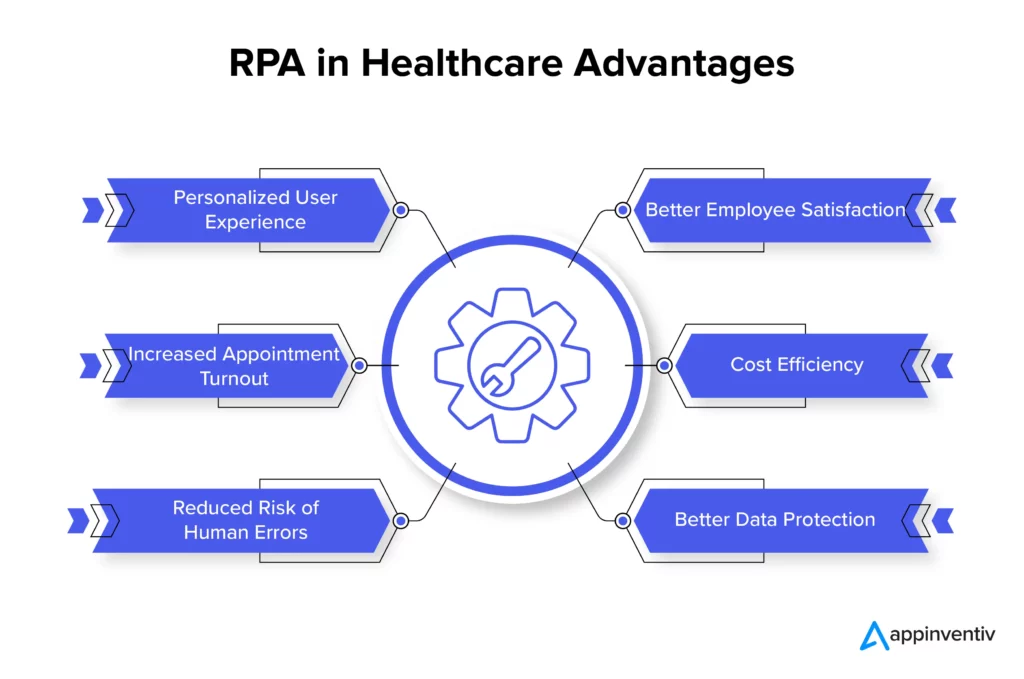
Personalized User Experience
Robotic Process Automation in healthcare is revolutionizing how medical professionals interact with their patients and deliver care. By automating rule-based and repetitive administrative processes, RPA provides a personalized user experience. This allows healthcare providers to concentrate more on patient care and enhance their overall experience.
Increased Appointment Turnout
Since RPA bots send timely reminders to patients about their appointment scheduling, it eliminates the need for human intervention and reduces the likelihood for the patient to forget about the appointment. Also, it helps schedule appointments at a much faster pace. All these capabilities of RPA lead to increased appointment turnout.
Reduced Risk of Human Errors
By implementing RPA in the healthcare industry, medical professionals can eliminate the risk of human error caused by fatigue, distraction, or oversight. This results in improved accuracy and enhanced data quality, leading to more efficient and reliable operations.
Better Employee Satisfaction
RPA helps employees by relieving them of repetitive and mundane tasks, enhancing their capabilities to provide better service. This frees up their time to get involved in more value driven and intelligence-based roles, thus improving their consistent growth and learning. The growth opportunities and the feeling of adding value to the company automatically increase employee satisfaction levels.
Cost Efficiency
It is a myth that technology integration costs a fortune. RPA services for the healthcare industry offer substantial savings by performing tasks quickly and efficiently while reducing the risk of errors. This, in turn, adds to saving on human resources costs while eliminating the repeated tasks because of mistakes and misses on compliance, thus improving patient care.
Better Data Protection
Data transfer is enhanced in automated processes, ensuring a higher level of security. In situations where humans are responsible for managing the reports section, there exists a potential risk of unintended access to the reports by another employee or an unauthorized individual. But RPA-powered automated processes restrict access only to authorized persons, ensuring a more secure environment for data handling.
Start reaping the benefits of RPA in healthcare today with our scalable services!
Real-life Examples of RPA in Healthcare: How Organizations Worldwide Are Leveraging the Power of Automation
There are many companies that have effectively incorporated RPA into their healthcare operations. Let’s look at a few actual cases of companies utilizing RPA services for healthcare:
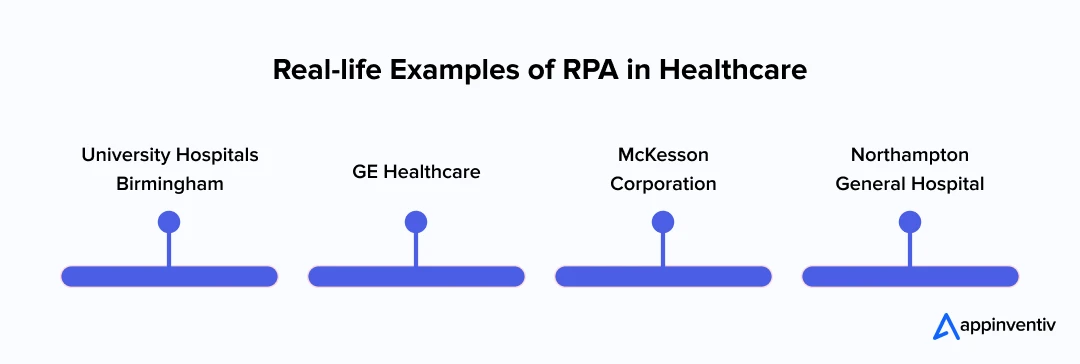
University Hospitals Birmingham
University Hospitals Birmingham (UHB), a major healthcare service provider in the UK, uses RPA with their patient administration system to streamline and improve the registration process for a large volume of patients.
Across their various healthcare facilities, UHB has deployed self-service kiosks, which have received high patient satisfaction ratings. This positive response is attributed to eliminating queues and the quick self-registration process.
By implementing these kiosks, UHB has witnessed the improvements in efficiency of its front-desk staff by 50% and patients registering with self-registration kiosk by 51%, all without hiring an additional 20-30 receptionists.
GE Healthcare
To improve its revenue cycle management procedures, GE Healthcare has realized the impact of RPA in healthcare and implemented it in its various processes. They have streamlined reimbursement procedures, decreased billing errors, and enhanced claims administration through automation.
McKesson Corporation
McKesson Corporation, one of the top providers of healthcare services, has been using RPA for healthcare to manage inventories, streamline the supply chain, and fill orders. With the right applications of RPA in healthcare, the company can now increase inventory precision, lower manual errors, and ensure prompt delivery of medical supplies.
Northampton General Hospital
Northampton General Hospital implemented an RPA solution to monitor oxygen tank levels during the COVID-19 pandemic. The bot logs into the supplier’s website, updates the hospital’s system, and provides instant updates on oxygen levels. This automation has freed up approximately 1,500 hours of staff time, allowing healthcare workers to focus more on patient care and reducing clinical risks associated with manual monitoring.
These are just a few examples of RPA in healthcare, demonstrating how companies are using robotic process automation for healthcare.
How to Implement RPA in Healthcare – A Step-by-Step Process
Now that you know robotic process automation in healthcare plays a game-changing role and companies worldwide are hopping on this tech trend, you might be wondering how to implement it in your healthcare operations. Well, to help you implement RPA in the healthcare industry, here is a structured, step-by-step process:
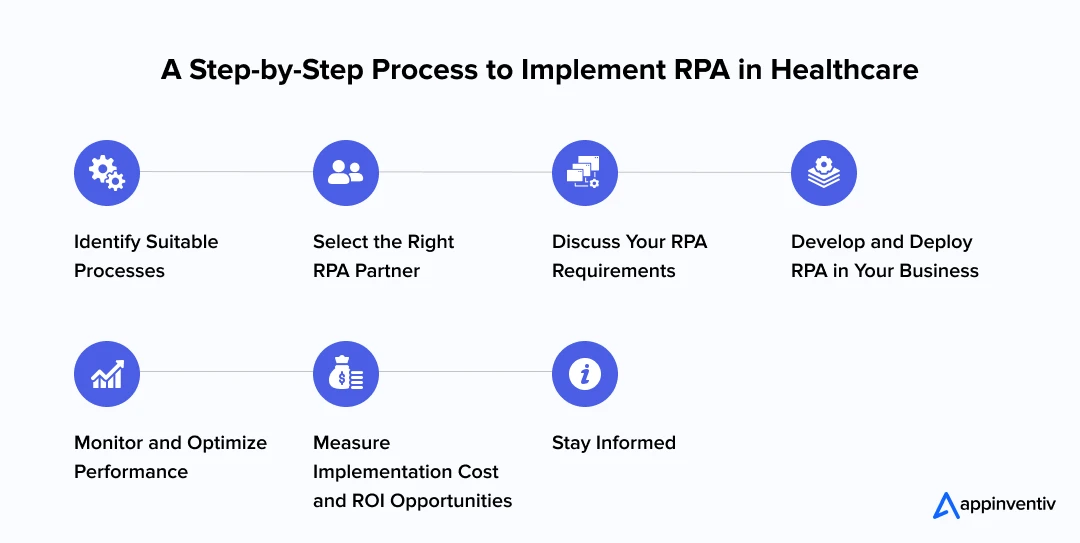
Identify Suitable Processes
Start your RPA implementation journey by identifying healthcare processes that are repetitive, rule-based, and have a high volume of transactions. These are the ideal areas for RPA implementation.
Select the Right RPA Partner
Ensure that you take a granular approach to automation by partnering with an experienced and reliable healthcare app development company (such as Appinventiv). The company you partner with should possess enough experience and expertise in building scalable healthcare apps. They should be thoroughly aware of medical compliances and have complete knowledge of implementing advanced technologies like AI, data analytics, and other patient privacy protection technologies.
Discuss Your RPA Requirements
Discuss your RPA requirements with the development team to automate the required process. Consider the limitations of your IT infrastructure, and take a progressive approach to a complete automation solution.
Develop and Deploy RPA in Your Business
In this stage, work closely with your development team to build the RPA bots tailored to your needs. This involves configuring bots to handle specific tasks, ensuring they align with your workflow. Once developed, integrate the bots with your existing systems, test for accuracy, and deploy them for real-time use.
Monitor and Optimize Performance
Regularly monitor the performance of your RPA powered healthcare processes. Based on the insight, make necessary improvements. Optimize workflows to ensure they remain efficient and effective.
Measure Implementation Cost and ROI Opportunities
Implementation of any new technology is normally weighed against the cost-saving that it will bring. Most healthcare organizations that implement RPA normally achieve the payback in time as small as 12 months. Thus, you must continuously measure the ROI of your RPA implementation. This will help justify the costs and showcase the benefits to the organization.
Stay Informed
Stay up-to-date with the latest RPA trends in healthcare. This will help you remain competitive and continue to improve your processes.
Implementation Challenges for RPA in Healthcare and How to Overcome Them
Implementing RPA in healthcare is indeed an integral step. However, its implementation is not easy. It is both useful yet challenging. But worry not. With the right approach, you can easily overcome the expected obstacles. Here are some of the most common barriers you might face while implementing RPA in the healthcare industry and the solutions to overcome those.
Regulatory Compliance
Challenge: The healthcare industry is heavily regulated to protect patient data. Thus, making sure that your RPA platforms comply with regulations like HIPAA, GDPR and PCI DSS can be nerve-racking.
Solution: Implement solid security measures like data encryption and adhere to data protection laws to make sure sensitive patient information stays safe.
Change Management
Challenge: Implementing RPA can shake up existing workflows, and some employees might be hesitant to adapt to the changes.
Solution: Get your employees involved early, give them thorough training, and help them see the benefits of RPA. Address any worries they have and keep offering support throughout the process so they feel confident using the new system.
Complex IT Infrastructure
Challenge: Healthcare organizations often have complicated IT systems, full of legacy applications. This makes RPA integration a real headache.
Solution: Analyze the current infrastructure, pinpoint integration points, upgrade the legacy systems, and collaborate with IT teams to find the best way to integrate.
Scalability and Maintenance
Challenge: As healthcare businesses expand, it can be difficult to scale RPA capabilities to manage growing volumes. Also, committed personnel are needed to update and maintain RPA bots regularly.
Solution: Develop a scalable RPA for healthcare that can efficiently handle a growing workload and adapt to future changes. Hire a dedicated AI development team to manage the RPA bot and maintenance, do routine audits, and continuously enhance procedures.
Cost of RPA Implementation in Healthcare
Seeing the transforming power of RPA in healthcare, you would be wondering about how much does it actually cost to implement RPA in healthcare? Well, there is no fixed price tag to quote the exact price tag. The final cost of RPA platforms development for healthcare varies, depending on the complexity of the tasks you’re automating, the number of bots and of course, the expertise of RPA developers, and so on.
On average, the cost to implement RPA and AI in healthcare ranges between $50,000 and $500,000 based on your project complexity. You should also consider the ongoing expenses for updating bots, fixing glitches, and scaling automation as needs grow.
Here is a brief table outlining an estimated healthcare app development cost and timeline for RPA implementation:
| Project Type | Cost Range | Timeline |
|---|---|---|
| Small-scale projects such as a single department in a clinic | $50,000 – $100,000 | 3-6 months |
| Mid-scale projects such as multiple departments in a hospital | $100,000 – $200,000 | 6-9 months |
| Enterprise grade deployments such as organization-wide automation | $200,000 – $500,000+ | 12+ months |
While the cost of RPA implementation seems substantial at first but the ROI it yields in the long run far outweighs the initial investment. Organizations often see a lucrative ROI within the first year.
The Future of RPA in Healthcare
The future of RPA in healthcare isn’t just about efficiency; it’s about reshaping how the system works from the inside out. Hospitals everywhere are under pressure to do more with fewer hands, and automation is quietly becoming the helping hand they didn’t know they needed.
Analysts estimate the RPA market in healthcare could jump from around $1.4 billion in 2022 to nearly $14 billion by 2032. That’s not just growth; it’s a sign that automation is stepping out of the back office and becoming part of daily care delivery.
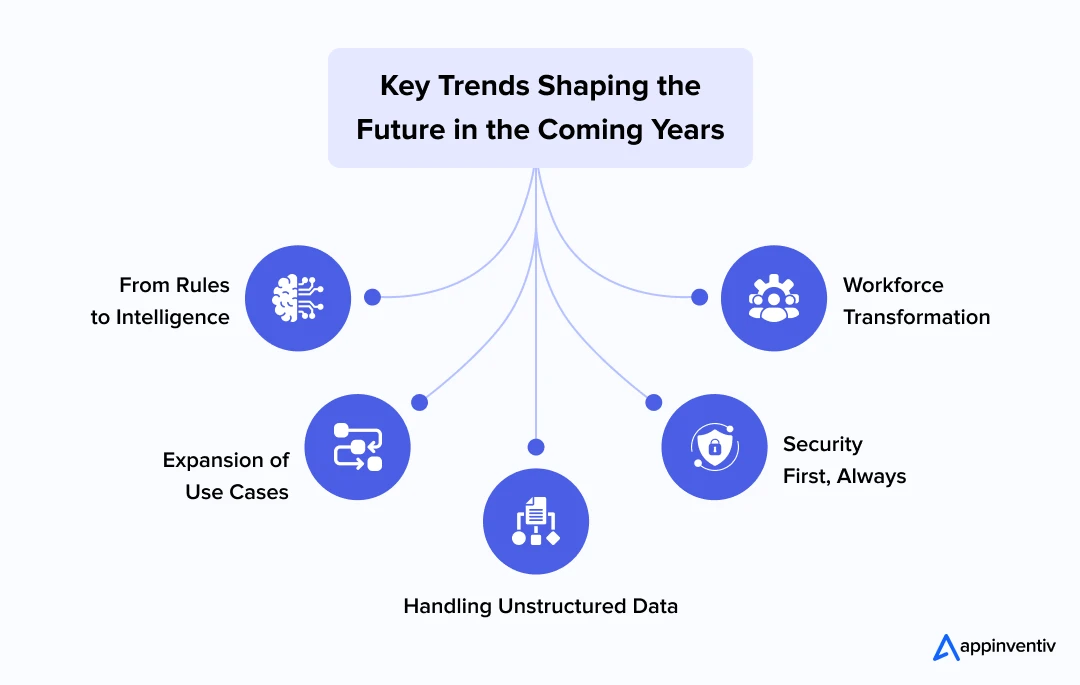
Key Trends Shaping the Future in the Coming Years
- From Rules to Intelligence
The early versions of RPA were good at ticking boxes and moving data from one system to another. The next phase will be much smarter. When combined with AI and machine learning, RPA can predict what comes next, like spotting patient risks early, sorting claims automatically, or even helping doctors prioritize cases.
- Expansion of Use Cases
RPA is no longer limited to billing or scheduling. It’s starting to assist with clinical workflows, remote monitoring, and even population health. Imagine bots helping nurses update records or automatically flagging anomalies in patient data that’s where things are heading.
- Handling Unstructured Data
Most of healthcare data isn’t tidy. Notes, prescriptions, scans, etc., half of it lives in free text. With natural language processing and intelligent document processing, RPA will finally start making sense of that chaos. The ability to handle unstructured data could be one of the biggest breakthroughs of the decade.
- Security First, Always
The more connected systems get, the higher the stakes. RPA in the future will come with security and compliance built in, encrypting sensitive data, maintaining logs automatically, and reducing the chance of human error in audit trails.ac
- Workforce Transformation
One of the biggest misconceptions about automation is that it takes jobs away. In reality, it takes away the dull work. When routine forms and reports get handled by bots, healthcare workers can focus on empathy, problem-solving, and patient care. These are the parts that can’t be automated.
RPA is moving from a supporting role to a strategic one. The hospitals that embrace it now won’t just save time; they’ll create space for care to feel human again.
How Can Appinventiv Help Implement RPA in Healthcare?
The healthcare industry is struggling with the scarcity of specialized resources and patient data management. In such a scenario, robotic process automation is the need of the hour. Delaying such an investment can lead to missed opportunities for increased efficiency and cost savings.
By partnering with a reputed healthcare app development company like Appinventiv, you can efficiently and swiftly implement RPA solutions into your existing systems.
We offer you the best-in-class RPA development services and build enterprise RPA solutions for healthcare organizations. We have a team of highly skilled AI/ML experts who have delivered more than 500+ digital healthcare projects for both startups and enterprises. For instance:
DiabeticU
We partnered with DiabeticU to fulfill their vision of developing an AI-driven diabetes management app. The app empowers users to track their blood sugar levels, medication, and dietary habits. Currently, DiabeticU is serving as a personal health companion for patients dealing with diabetes, giving them control of their wellbeing.
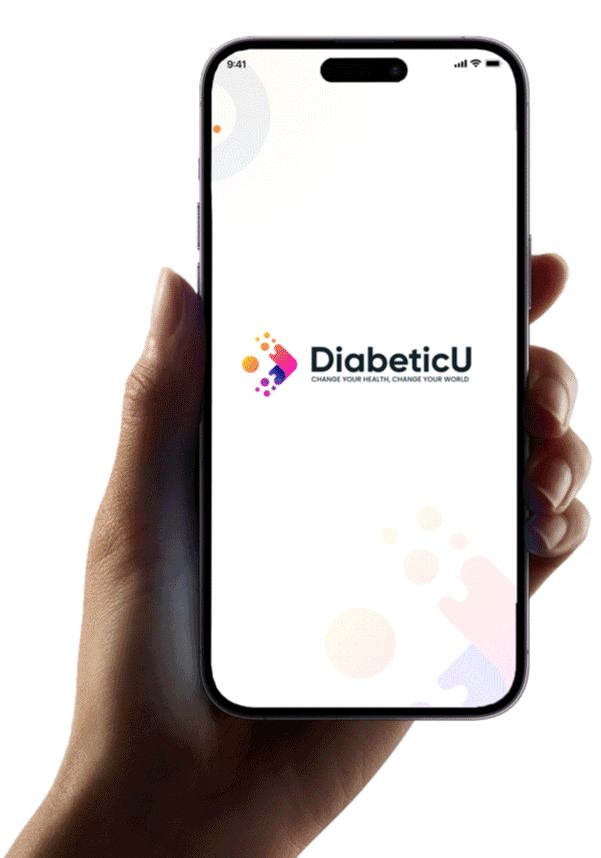
Health-e-People
We have also developed Health-e-People to build a health assessment app that consolidates data from over 200 health devices and applications into a user-friendly interface. Result? The platform gives users a 360 degree view of their condition and empowers them to monitor various health metrics in real-time.
Health-e-People App Screens
Soniphi
For another client, Soniphi, we built an application based on a resonant frequency-based personal wellness system. We integrated the concept of human bio-acoustic into mobile devices to witness the relationship between a voiceprint and the physiology, personality, structure, and function of the human body.
YouCOMM
We have built a revolutionary solution for YouCOMM, transforming their in-hospital patient communication by providing real-time access to medical help. With a customizable patient messaging system, patients can easily notify staff of their needs through voice commands and hand gestures.
Our Impact on Healthcare
We have not only built healthcare platforms, in our 10+ years of industry experience, we have delivered real-world results that count.
- 99.90% Uptime for Critical Systems
- 45% Operational Efficiency Gains in Hospitals
- 90%+ Clinical Data Accuracy Achieved
- 95% Patient Satisfaction in Deployed Apps:
Discuss your requirements with our RPA experts, and we will automate your healthcare operations, enabling you to provide the best services to your patients.
FAQs
Q. What is RPA in healthcare?
A. Robotic process automation in healthcare refers to the implementation of technology that helps redefine the entire healthcare landscape. How? It automates time-consuming and repetitive tasks, accelerating administrative processes such as patient registration, claims processing, and data entry.
Q. Can RPA bots disrupt the current workflows at a clinic?
A. RPA bots are meant to enhance, not disrupt, workflows. However, when first introduced, there may be a learning curve for staff as they adapt to new processes.
By automating routine tasks, RPA frees up staff time, allowing them to focus on more critical, patient-centric tasks. With the right implementation partner and proper training to staff, RPA can seamlessly integrate into existing workflows without any disruption.
Q. How can RPA improve hospital operations?
A. RPA can improve hospital operations in various ways, such as it:
- Streamlines administrative tasks like scheduling, billing, and data entry.
- Reduces errors and improves accuracy in patient records.
- Speeds up processes and improves efficiency across departments.
- Allows healthcare professionals to focus on patient care, not paperwork.
Q. What is the difference between RPA and AI in healthcare?
A. The key difference between RPA and AI in healthcare is:
- RPA automates routine tasks like scheduling, claims processing, etc., whereas AI analyzes data and makes intelligent decisions such as predicting patient outcomes, diagnosing and so on.
- RPA handles the execution of tasks, while AI provides insights and decision support.
In short, both AI and RPA work together to improve healthcare operations and patient outcomes; RPA automates and AI enhances.
Q. How is RPA revolutionizing healthcare processes?
A. RPA in healthcare revolutionizes the industry by streamlining workflows, reducing administrative burdens, and enhancing patient care. Here is how RPA does it:
By automating tasks like data entry, insurance claims processing, and patient scheduling, RPA reduces errors and operational costs. This speeds up processes, improves accuracy, and ensures that healthcare providers can focus more on direct patient care.
RPA’s ability to integrate with existing systems also creates a seamless workflow. This results in better patient experiences and increased operational efficiency.
Q. What is the role of RPA in reducing claim denials & improving revenue?
A. RPA plays a key role in reducing claim denials. It ensures accurate data entry and automates the validation of insurance information before claims are submitted.
By cross-referencing patient data with insurance policies and confirming eligibility, RPA reduces errors that lead to denials. This leads to faster approvals, reduced claim rework, and ultimately improved revenue cycles.
Additionally, RPA can automate the resubmission of denied claims, ensuring more claims get paid and revenue is maximized.
Q. How does RPA improve efficiency and accuracy in the healthcare industry?
A. RPA has revolutionized healthcare by automating repetitive tasks, reducing human errors, and enabling seamless data integration. It has allowed healthcare professionals to focus on more important tasks while enhancing precision in processes like data entry and claims processing.
With comprehensive patient information analysis, RPA can enhance the quality of patient care and improve overall healthcare outcomes. The future of the industry cannot be imagined without the applications of RPA in healthcare. So, if you want to improve healthcare efficiency and accuracy, consider implementing RPA in the healthcare sector today.
Q. How do you calculate the ROI of an RPA solution?
A. The ROI is calculated considering the following:
- Number of processes that are to be automated
- Number of resources required to automate the process
- Time required to complete the task
- Cost of deployment of these resources


- In just 2 mins you will get a response
- Your idea is 100% protected by our Non Disclosure Agreement.
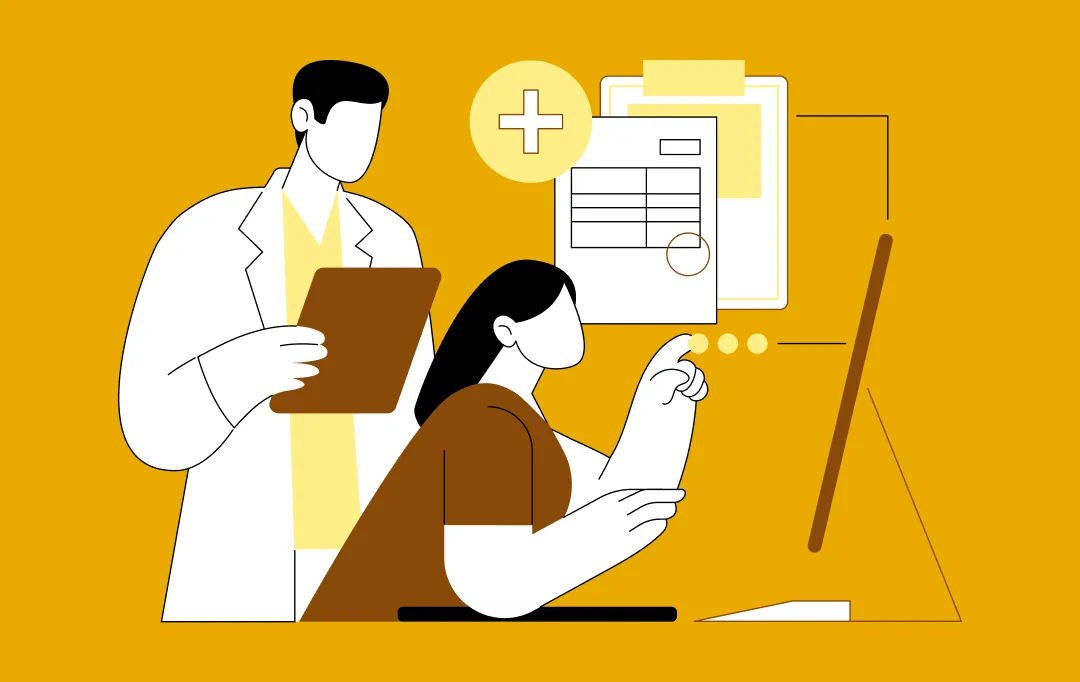
How Much Does It Cost to Build a Healthcare App in Saudi Arabia? All You Need to Know
Key takeaways: Healthcare app costs in Saudi Arabia range from 112,500 SAR to 2,250,000+ SAR based on size and complexity. The type of app you build matters more to cost than anything else. Compliance, security, and scalability are built into the cost, not add-ons. Development and testing consume the largest share of the budget. Hidden…
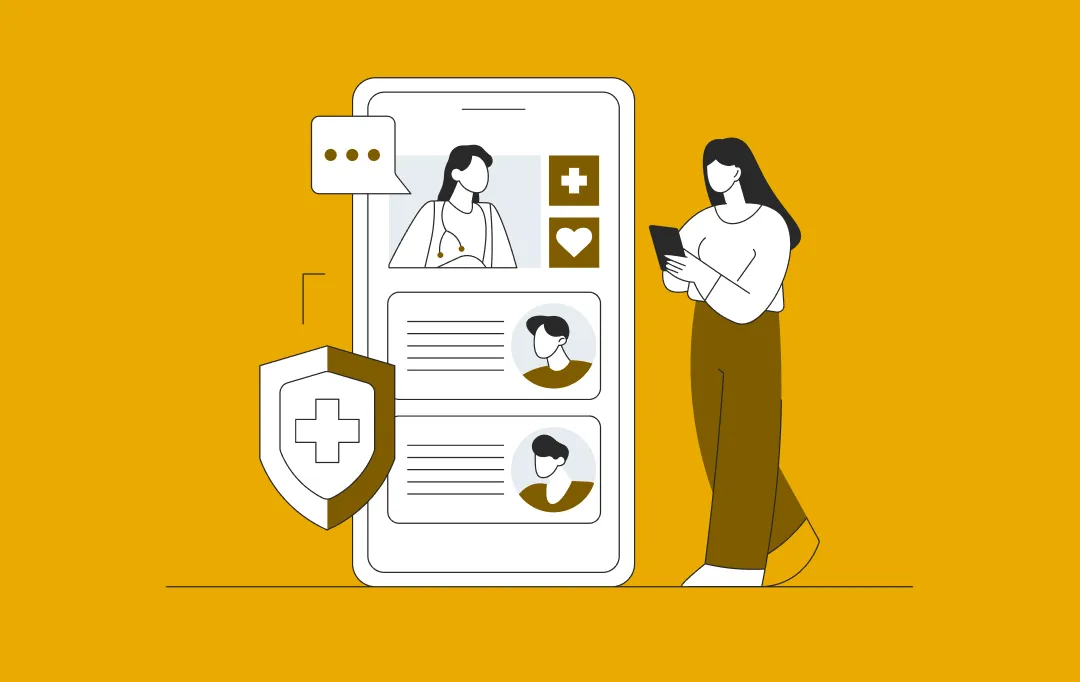
How Prescriptive Analytics Is Shaping the Future of Healthcare Management
A healthcare business doesn’t fall behind because its teams lack skill. It falls behind when decisions take too long. Bed allocation runs on yesterday’s data. Procurement reacts only when shortages hit. Care managers step in after a patient is already at risk. And leadership gets a picture of what’s happening only after the quarter closes,…
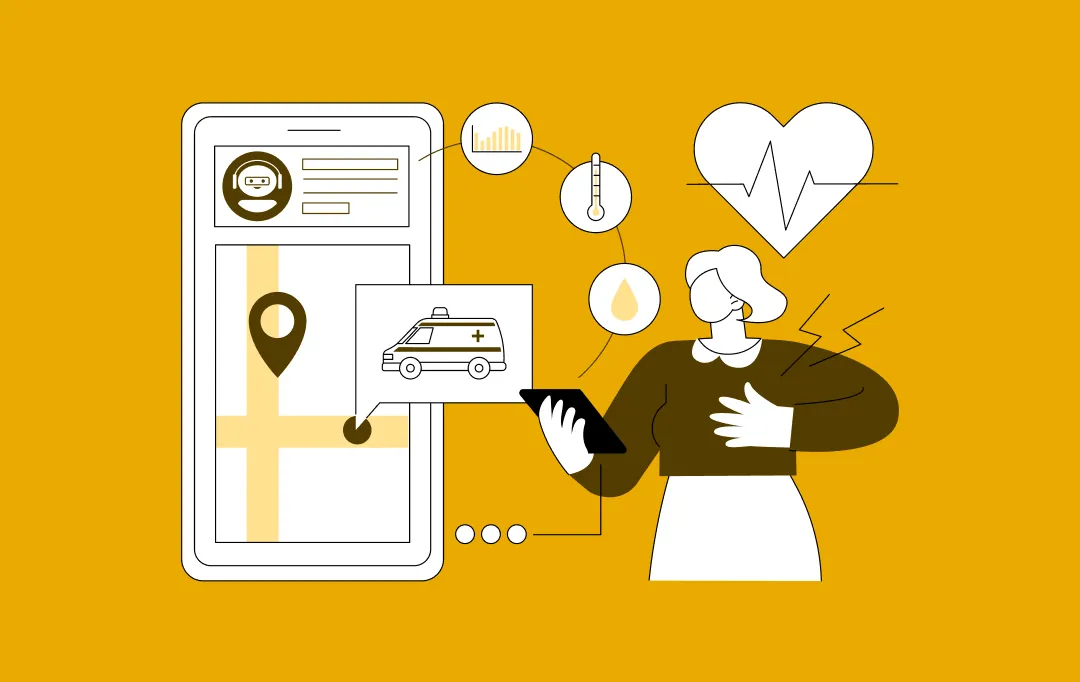
How to Build an Urgent Care App? A Step-by-Step Process, Features and Costs
Key takeaways: With more people turning to digital healthcare, the urgent care app market is expected to touch $3.1 billion by 2024 and continue growing fast through 2030. Apps that offer easy scheduling, video consultations, EHR access, and quick insurance handling tend to attract more users and keep them coming back. Developing an urgent care…












